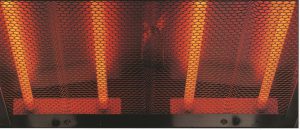Bomac’s High Speed grill is still a best seller, unbeaten in terms of both heat-up speed and cooking performance. In this article, our Managing Director tells us about its history and why using Neoceram glass tubes makes such a difference to both performance and longevity.
History
During the mid-1990’s Bomac was manufacturing large quantities of glass tube radiant heating elements for use as grill/browning elements in microwave ovens being produced in the UK factories of Japanese owned manufacturers.
The expertise we developed in this field enabled us to expand our customer base to Korean owned oven manufacturers and several microwave oven factories in mainland Europe.
Although the use of radiant elements for grilling/browning was not new, the concept of using glass tube elements, giving much improved performance in terms of heat-up times and cooking speed over conventional metal sheathed elements, was new, however, having originated in Japan.
At Bomac we were aware that a frequent consumer complaint of the performance of conventional electric cookers related to that of the grill, being of the metal sheathed type, in that it was slow to heat up, gave long cooking times and very uneven results across the full width of the grill pan.
We then embarked on a development programme to establish the viability of using an array of 4 glass tube radiant elements as a direct replacement for a conventional metal sheathed grill element.
We interested a major, then UK based, cooker manufacturer in the project and worked with them to develop a metal frame based assembly of 4 heater tubes interconnected by stainless steel strips complete with ceramic lead-out insulators carrying the electrical connecting strip out through the back wall of the oven cavity. The interconnections allowing for half grill/full grill operation. An expanded stainless steel protective mesh was incorporated. The resulting assembly was very easy to install, requiring minimal modification to the cooker. We then completed extensive performance, life testing and safety evaluations leading to acceptance and integration into their cooker line to full production in 2001. Market reaction was very favourable, the cooker meeting with considerable commercial success.
Advantanges of using Neoceram
Production continues, with only minor product updates, to this day although the production of the cookers in question has long departed these shores!
Having, by the time we embarked on this project, worked for some years with Japanese microwave oven producers, we had come to appreciate the differences between diffuse quartz tubes and NEOCERAM glass ceramic tubes.
Diffuse quartz (Silica) tubes had been used extensively in the UK and Europe for radiant heating elements for many years for applications as diverse as domestic room heaters (electric fires) to industrial process heating.
On the other hand glass ceramic, Neoceram, tubes were almost unknown outside Japan and Korea. The material is essentially the same as the glass ceramic material being used, in flat sheet form, for cooking surfaces on ceramic top electric cookers.
The advantages, for use as a sheath material in radiant heating elements for cooking applications, of Neoceram glass ceramic over diffuse quartz are as follows;-
1) The infra-red transmission properties of Glass ceramic are superior to those of diffuse quartz as the radiation is not diffracted on its passage through and can pass straight through in straight lines unlike transmission through diffuse quartz where the included “air lines” cause scattering of the infra-red radiation.
2) This results in faster cooking times but also reduces the maximum temperature of the heater coil resulting in a much longer service life.
3) Diffuse quartz, although quite capable of withstanding prolonged exposure to a very high ambient temperature (1000 deg.C), suffers from one major weakness; it is susceptible to devitrification by which the glass material reverts to its natural amorphous form (sand!) when this happens the infra-red transmission properties of the material rapidly deteriorate resulting in element coil failure due to overheating. Additionally the material loses its mechanical strength and will, eventually, just crumble away.
This devitrification process is triggered by exposure to alkaline substances such as salt and many substances released from food during cooking and distributed throughout the oven cavity by the splashing and spitting normally associated by the grilling process.
Microwave ovens have “got away” with using diffuse quartz tubes because the actual use in practice tends to be fairly limited. Grills in conventional cookers and commercial catering equipment, however, can expect a far more demanding service life.
For this reason, we do not offer glass tube based grill elements using diffuse quartz tubes for conventional cookers or commercial catering equipment.
Click here to see the full product page https://www.bomac-elec.co.uk/wp-content/uploads/2018/09/BOMAC-Inserts-Neo-Speed-Cooker-Grill.pdf
PETER BOWEN
MANAGING DIRECTOR
BOMAC ELECTRIC LIMITED






